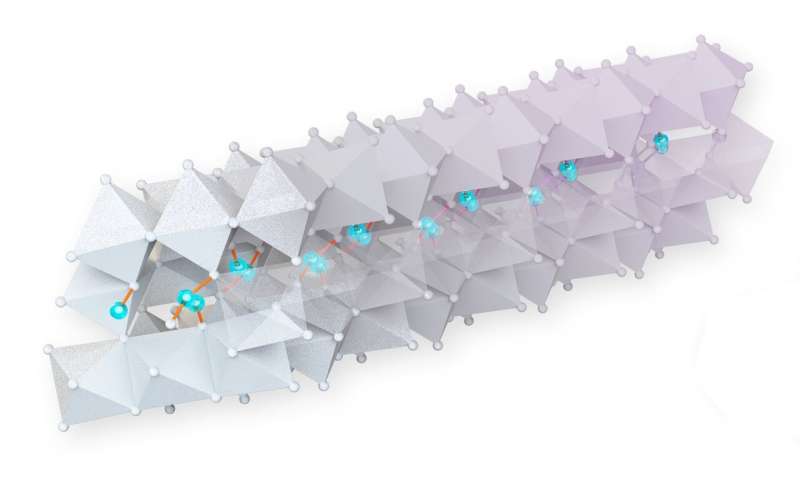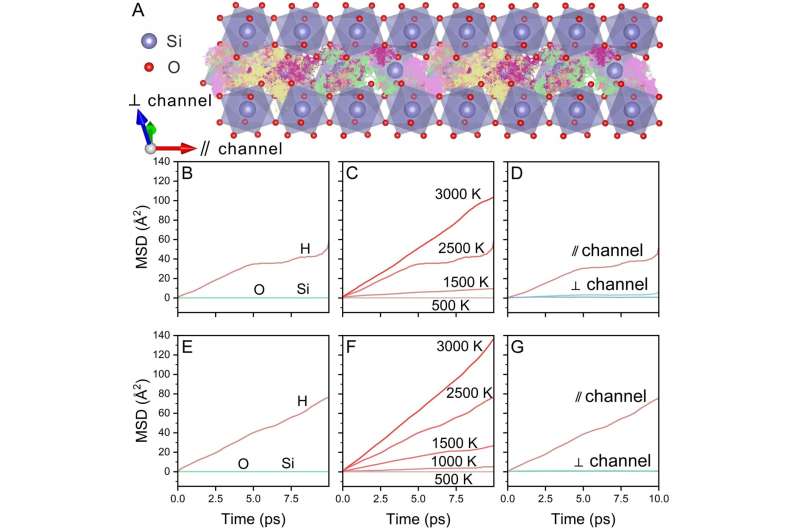September 7, 2023 dialog
This article has been reviewed according to Science X's editorial process and policies. Editors have highlighted the following attributes while ensuring the content's credibility:
fact-checked
peer-reviewed publication
trusted source
written by researcher(s)
proofread
Digging water channels in mineral stishovite

Stishovite has the same chemical formula as silica quartz (SiO2) but it has much higher density. While SiO2 is abundant on Earth's crust, it is also a major component of basalt, a type of igneous rock that is rich in iron and magnesium. When basalt in the oceanic crust subducts into Earth's deep interiors, it is subjected to high pressures and temperatures, triggering basaltic melting and fluid release, i.e., liquid water. These fluids can then react with the surrounding mantle rock, changing its composition.
"This might not be the case if stishovite can absorb a lot of water," says Junwei Li, the leading author from the Center for High Pressure Science and Technology Advanced Research (HPSTAR), Beijing China. Stishovite can incorporate a weight-percentage level of water. Thus, stishovite in the Earth's mantle can store such enormous amounts of water that is equivalent to a few oceans of water on the Earth's surface. This research is now published in the journal Science Advances.
The leading consensus of the geo-science community is that water incorporating into stishovite is either realized by hydroxyl group (OH-) absorption into the crystal lattice or by forming defect structures via silicon replacement. Both mechanisms have been well studied in the past but it was unclear, as of now, which become dominant at the elevated pressure and temperature conditions of the Earth's mantle.
"We employed a revolutionary structural searching algorithm called LASP that found the most favorable water coordination sites in dense stishovite at high temperatures," said Dr. Shengcai Zhu, an associate professor from Sun Yet-Sen University, Guangzhou China.
This algorithm is based on a machine learning algorithm, accelerating the speed of the structural search by several orders of magnitude. Hydrous stishovite contains more than 100 atoms per unit cell, and the combination of proper searching algorithms and machine learning make it possible to locate stable structures at reasonable computational costs.
The results indicate hydrous stishovite to be stabilized in stishovite-water superstructures exhibiting one-dimensional water channels. Hydrogen atoms will behave as fluids inside the channels at temperatures above 1,000 K, leading to an exotic 1D superionic state, similar to high pressure water-ices at high pressures and temperatures (see figure below).

Therefore, hydrous stishovite could feature high ionic mobility, which could explain the previously observed electrical heterogeneity in the Earth's mantle. Given these encouraging results, the research team set out to synthesize samples in a laboratory environment. However, synthesis and characterization proved to be very challenging for those predicted stishovite-water superstructure.
"Although a series of hydrous stishovite samples have been synthesized in the past decade, either they contain a considerable amount of alumina or they are synthesized at relatively low pressure and temperature conditions," said Dr. Yanhao Lin, a staff-scientist at HPSTAR. "It was a very first attempt to synthesize Al-free Stishovite single crystals containing wt-% levels of H2O at P-T conditions approaching the lower-mantle geotherm."
"Measuring hydrogen in nominally anhydrous minerals, especially for such minuscule samples as we were able to prepare, is technically challenging," Dr. Thomas Meier (HPSTAR) said. "Conventional structural characterization techniques such as X-ray diffraction are powerless due to the weak elastic scattering of hydrogen atoms. In order to solve this problem, we used a Nuclear Magnetic Resonance spectroscopy adopted for the detection of ultra-small samples. NMR is particularly sensitive to hydrogen nuclei."
The detected 1H-NMR signals, a fingerprint of the short-scale local environment of each nucleus of hydrogen, exhibited characteristics which were found to validate the super-structural predictions of the research team.
The unique stishovite-water superstructure opens exciting opportunities for exploring novel minerals. Hydrous stishovite is no longer the original stishovite by crystallographic definition. "It is a new mineral," said Dr. Ho-kwang Mao, the chief scientist at HPSTAR.
Water is known to alter the structure of minerals but it is not expected to form a superstructure with a water channel passing through. This might not be a unique structure for stishovite, but it potentially exists in other minerals. The existence of superionic water channels will also largely modify the physical properties of stishovite. For example, since H-atoms diffuse along certain directions, its electrical properties will be highly anisotropic. The discovery of stishovite-water superstructures will refresh our conventional view of water reservoirs in Earth's deep interiors.
This story is part of Science X Dialog, where researchers can report findings from their published research articles. Visit this page for information about ScienceX Dialog and how to participate.
More information: Junwei Li et al, Silica-water superstructure and one-dimensional superionic conduit in Earth's mantle, Science Advances (2023). DOI: 10.1126/sciadv.adh3784
Journal information: Science Advances
Qingyang Hu is Staff Scientist at the Center for High Pressure Science and Technology Advanced Research, Beijing, China.




















